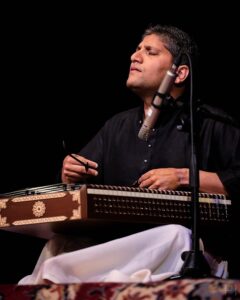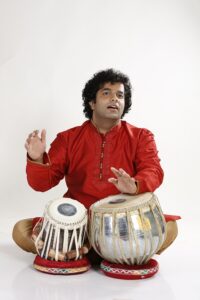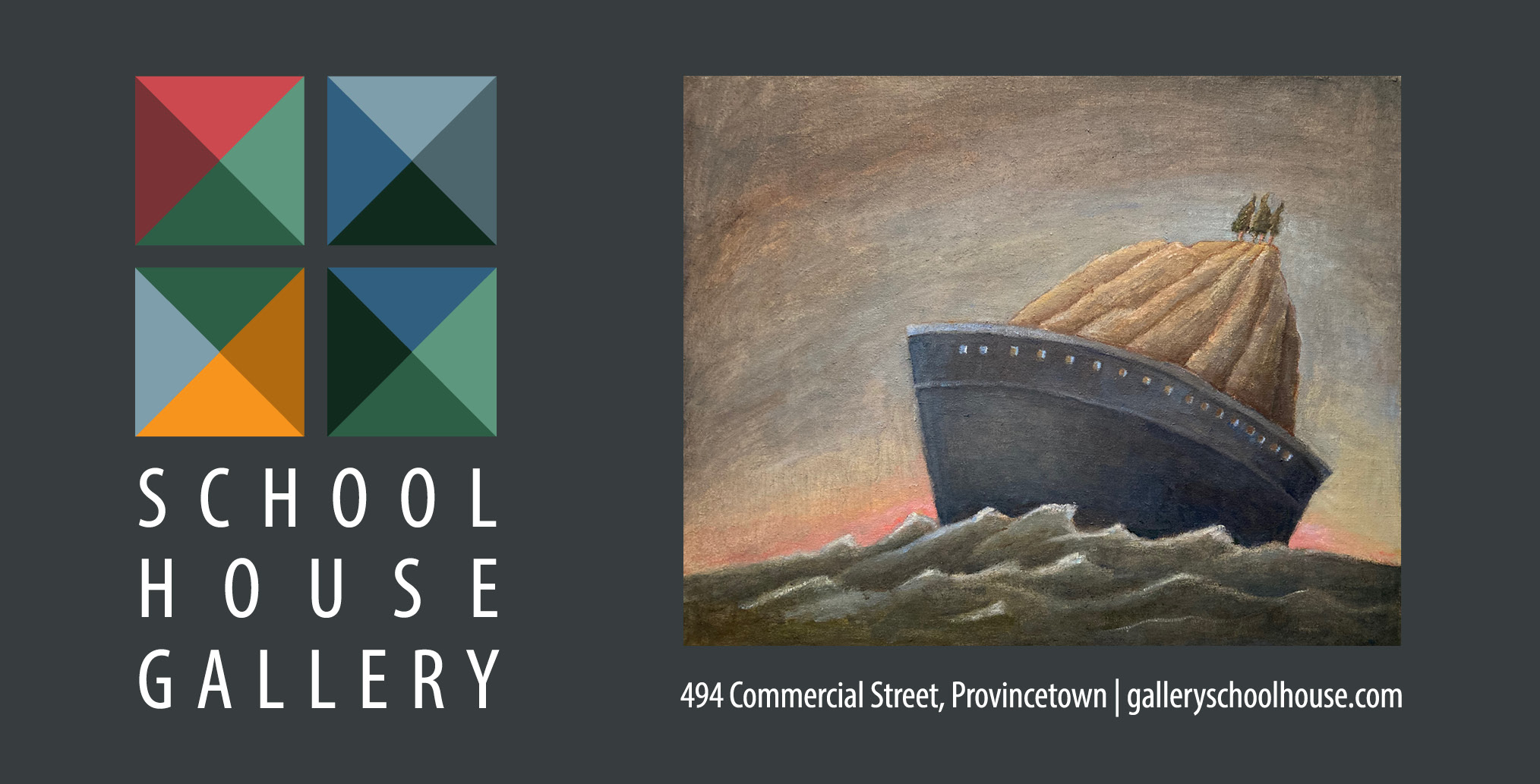More than 1,500 years ago, the santoor, a trapezoidal instrument with 100 metal strings tightly stretched over 25 wooden bridges, made its way along the Silk Road, carried from Iran by merchants, traders, artists, and travelers bound for Jammu and Kashmir in northern India.

Kunal Gunjal learned to play the instrument from his guru, the late Pandit Shivkumar Sharma. Struck with two delicate mallets, the santoor is percussive and melodic at once, with an icy, sparkling timbre. It’s mainly used as a solo instrument, says Gunjal, in classical Indian ragas, which are the musical frameworks, akin to modes, that allow for improvisation over a tonic drone. But with its improvisational strength, the santoor lends itself to other genres, he says, like American jazz. It’s also strikingly similar to the hammered dulcimer used in Appalachian and bluegrass music.
With his longtime musical partner and accompanist, tabla player Amit Kavthekar, Gunjal will perform at Wellfleet Preservation Hall on Thursday, July 31 in a concert presented by Secret Planet Cape Cod, a co-production of Cape Symphony Presents and Narrowland Music. Their show is called “Soundscape.” Half the music is newly composed by Gunjal, and half is traditional: Indian classical music but also music from the American jazz and blues canon. The concert traverses cultural distances, allowing genres to “come together to paint a different picture,” says Gunjal.
In a landscape, Gunjal says, “you have hills, you have sunsets, you have vineyards.” In “Soundscape,” rhythm, melody, and the eccentric character of improvisation illustrate a multicultural musical geography. Onstage, says Kavthekar, “We look at each other, and we know exactly where we are and where we’re going.”
One jazz tune Gunjal has adapted for the show is Dave Brubeck and Paul Desmond’s legendary “Take Five” in five-four time — that is, five beats per measure, with the quarter note getting one beat. According to a 2000 report on NPR, Brubeck returned from a trip to Turkey in 1958 with the idea of composing in unusual time signatures.
The saxophone melody in “Take Five” is based on an E-flat minor blues scale. That scale is similar to the raga Kirwani, which is rooted in the harmonic minor, says Gunjal. In performance, he says, “I might start with ‘Take Five’ and then go into that raga.” Both tunes feel like they’re on the edge of something; forward leaning and unstable, searching for resolution.
Gunjal says he often listens to the American guitarist Al Di Meola. “The sound of the acoustic guitar is very close to the santoor,” he says — it doesn’t slide easily, the way an electric guitar does. Di Meola’s style is largely staccato, with resonance coming from the movement of shorter notes and their echo.
Kavthekar was on tour with Di Meola recently. He asked the guitarist if he’d been influenced by Indian classical music — Kavthekar was sure he heard the sound of ragas in Di Meola’s melodies. But Di Meola said that his music came only from his own head. Gunjal notes that similar-sounding scales can emerge without a common influence. “Inspiration can come from so many things,” he says.
One of those things is the four-note song of Big Ben, the great bell of the Westminster tower clock. Its notes resemble a scale in Indian music, the raga Hamsadhwani, says Gunjal. He sings the scale; it sounds like Big Ben’s song; he allows it to wander before it returns home.
When Gunjal plays an Indian composition, Kavthekar drums the rhythm: cycles of 8, 9, and 16. “As the composition changes, he might divide it up,” says Gunjal. A 16-beat cycle becomes four sections of four, more like standard jazz. The musicians swing back and forth between classical and jazz, moving one way, then the other. “It’s almost like a pendulum,” says Gunjal.
All this travel occurs while Gunjal and Kavthekar sit cross-legged on the ground: the santoor held reverently in Gunjal’s lap, and the tablas — two small drums, one tuned to the tonic of the raga — positioned on cushions in front of Kavethekar.
The seated position isn’t just comfortable, says Kavthekar: it’s grounding. “When you meditate, you sit down,” he says. On the floor beside each other, on the same level as the instruments, he says, “There’s no air in your head.”

When Kavthekar plays the tablas, the movements of his hands are like second nature: the four fingers of his right hand tap intricate rhythms, and with his left hand he alternates between his fingertips and a flat hand. “These two hands complement each other,” he says. The right tabla is tuned, and the left one, which provides the bass, is not. Their syllables are a language, he says. The drums are only four or five inches across, but “every centimeter there’s a different sound” Kavthekar says.
In “Soundscape,” Gunjal and Kavthekar traverse emotional distance, too. The santoor is a soulful instrument, says Gunjal. “It transports me into a totally different world,” he says, “almost a meditative state.” Whatever he feels on the day of the concert emerges through the instrument.
The audience’s responses aren’t always predictable. Once, he played a song he thought was joyful, and a listener told him it brought them to a place of sadness “but that the melody gave them some peace.”
Gunjal and Kavthekar have history: they met 20 years ago in Kavthekar’s native Mumbai when Gunjal needed a tabla accompanist for a concert. Gunjal was born in the city of Pune. Both men now live in Boston. Their gurus knew each other well — Kavthekar learned from Ustad Alla Rakha and Ustad Zakir Hussain, father and son.
In performance, Gunjal and Kavthekar speak to each other in wordless gestures as small as a pointed stare. “If my tabla is out of tune, Kunal will just look at me and look at the tabla,” says Kavethekar. The message is understood.
A good accompanist knows the main artist so well, says Kavthekar, that words are not necessary. “My teacher used to say that you should know what he’s going to play, what music he likes, what food he likes, what fragrances — all the stuff that comes through the music.” When two musicians understand each other, he says, “the music becomes different.”
Like jazz soloists exploring the outer limits of a chord progression, Gunjal and Kavthekar, grounded by the tonic drone, improvise freely. “We don’t have anything written; we have a clean slate,” says Kavthekar. “We just make the picture right there.
“The roots are there,” he says, “like our own original face. We change our faces — or the music — as we go in different ways.”
Connectivity
The event: “Soundscape,” a concert by Kunal Gunjal and Amit Kavthekar
The time: Thursday, July 31, 7 p.m.
The place: Wellfleet Preservation Hall, 335 Main St.
The cost: $35 at wellfleetpreservationhall.org



